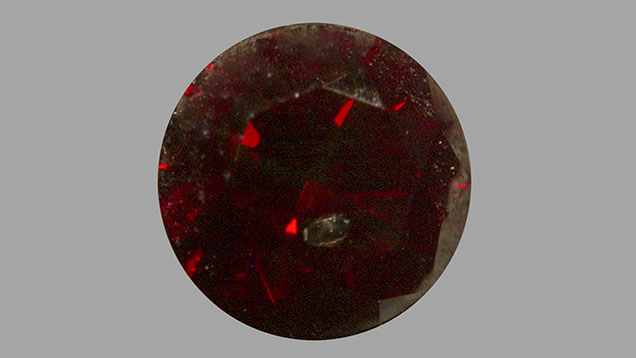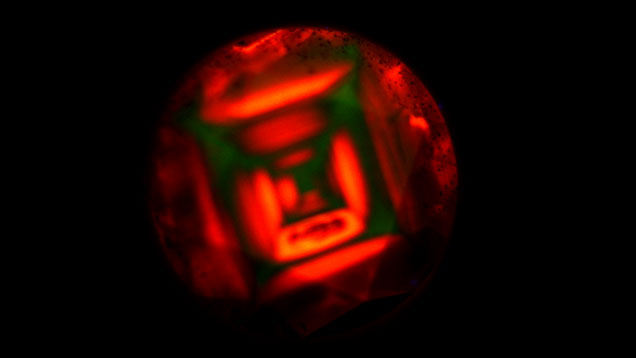Mixed-Type Treated Red HPHT Synthetic Diamond

A multiple-treatment process involving irradiation and HPHT annealing can produce pink to red color in natural and synthetic diamonds; specimens treated by this process have been on the market for over 10 years. To the best of our knowledge, nearly 95% of the studied red HPHT synthetic diamonds treated by the multi-treatment process are classified as type Ib or type IIa. Recently, we examined a treated red HPHT-grown synthetic diamond that was confirmed to be mixed type (IaA + IaB + Ib).
The 0.27 ct round brilliant sample, graded as Fancy Dark red (figure 1), had a metallic inclusion under the table. The DiamondView image showed strong red fluorescence and cuboctahedral growth structure; the latter is a typical feature of HPHT-grown diamonds (figure 2). Ni-related defects at 883.1/884.8 nm and 793.6 nm were revealed by a photoluminescence (PL) spectrum at liquid-nitrogen temperature with two different laser excitations (532 and 785 nm). The H2 defect corresponding to a sharp peak at 986.2 nm and the NV center associated with a strong peak at 637 nm were also found. In addition, the Fourier-transform infrared (FTIR) absorption spectrum (figure 3) confirmed the material was an uncommon type of IaA + IaB + Ib, with absorptions at 1282 cm–1 (A center), at 1175 cm–1 (B center), and at 1131 and 1344 cm–1 (C center), respectively (again, see figure 56). This mixed type is similar to that observed in treated natural diamonds. A moderate 1450 cm–1 absorption (H1a), which correlates with irradiation and subsequent annealing (Clark et al., “Absorption spectra of natural and irradiated diamonds,” Proceedings of the Royal Society of London A, Vol. 234, 1956, pp. 363–381), was also present. Thus, this diamond was identified as a multi-step treated HPHT synthetic diamond, with irradiation and HPHT annealing indicated as treatment processes.


Although most of the recent treated red HPHT synthetic diamonds are reported to be type Ib or type IIa (e.g, Fall 2016 Lab Notes, pp. 308–309; C.M. Breeding and J.E. Shigley, “The ‘type’ classification system of diamonds and its importance in gemology,” Summer 2009 G&G, pp, 96–111), such diamonds with mixed type Ia + Ib are available in the jewelry market, as exemplified by this study. Therefore, caution is still needed to distinguish such treated synthetic diamonds from treated stones of natural origin, as they may show similar characteristics.



